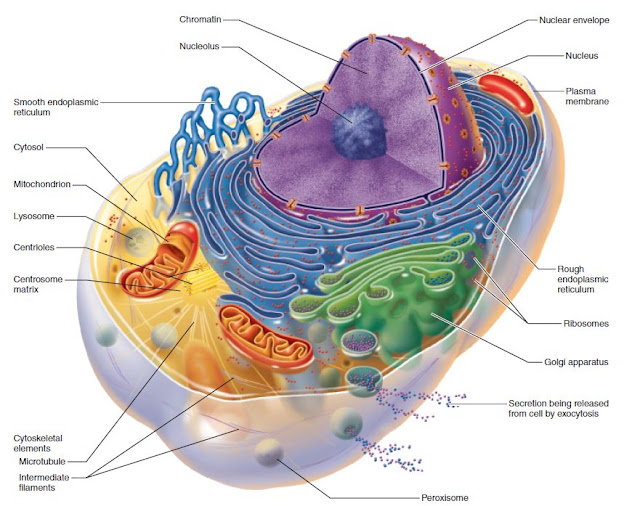All living organisms are cellular in nature, from one-celled “generalists” such as amoebas to complex multicellular organisms such as trees, dogs, and humans. Just as bricks and timbers are the structural units of a house, cells are structural units of all living things. The human body has about 50 to 100 trillion cells.
Cells are the smallest living units in the body. Each cell performs all the functions necessary to sustain life. Each cell can:
These functions are carried out by the cell’s many subunits, most of which are called organelles (“little organs”). Although different cell types perform different functions, virtually all human cells contain the same basic parts and can be described in terms of a generalized cell. Human cells have three main parts: the plasma membrane, the cytoplasm, and the nucleus (Table 2.1). The plasma membrane is the outer boundary. Internal to this membrane is the cytoplasm, which makes up the bulk of the cell, contains most of the cellular organelles, and surrounds the nucleus. The nucleus controls cellular activities and lies near the cell’s center. Think of the cell as a manufacturing plant. Each organelle functions like a specific division of the factory:
Structure of a generalized cell. No cell type is exactly like this one, but
this composite illustrates features common to animal cells. Not all of the organelles are
drawn to the same scale in this illustration.
OVERVIEW OF CELLS
The scientist Robert Hooke first observed plant cells with a crude microscope in the late 1600s. However, it was not until the 1830s that two scientists, Matthias Schleiden and Theodor Schwann, boldly asserted that all living things are composed of cells. Shortly thereafter, the pathologist Rudolf Virchow extended this idea by contending that cells arise only from other cells. Virchow’s thesis was revolutionary because it challenged the prevailing theory of spontaneous generation, which held that organisms can arise from nonliving matter. Since the late 1800s, cell research has been exceptionally fruitful. Currently, scientific knowledge about the cell is increasing exponentially.
Cells are the smallest living units in the body. Each cell performs all the functions necessary to sustain life. Each cell can:
- Obtain nutrients and other essential substances from the surrounding body fluids.
- Use these nutrients to make the molecules it needs to survive.
- Dispose of its wastes.
- Maintain its shape and integrity.
- Replicate itself.
These functions are carried out by the cell’s many subunits, most of which are called organelles (“little organs”). Although different cell types perform different functions, virtually all human cells contain the same basic parts and can be described in terms of a generalized cell. Human cells have three main parts: the plasma membrane, the cytoplasm, and the nucleus (Table 2.1). The plasma membrane is the outer boundary. Internal to this membrane is the cytoplasm, which makes up the bulk of the cell, contains most of the cellular organelles, and surrounds the nucleus. The nucleus controls cellular activities and lies near the cell’s center. Think of the cell as a manufacturing plant. Each organelle functions like a specific division of the factory:
- The plasma membrane is the boundary fence and security gate; it forms the boundary of the cell and selectively allows materials to pass into and out of the cell.
- Ribosomes are the assembly line; they produce proteins.
- Endoplasmic reticulum (ER) is part of the production division; rough ER produces proteins, and smooth ER metabolizes lipids and stores calcium.
- Golgi apparatus is the packaging and shipping division; it packages proteins for use either within or outside of the cell.
- Lysosomes are the janitorial crew and recycling center; they break down used proteins and other cellular debris.
- Mitochondria are the power plant; they make energy.
- Peroxisomes are the toxic waste treatment facility; they neutralize and remove toxic substances within the cell.
- Cytoskeletal elements form the framework and infrastructure of the building; they maintain cell shape and structure and transport materials within the cell.
- The nucleus is the chief executive officer (CEO); it directs the operation of the cell

Comments
Post a Comment